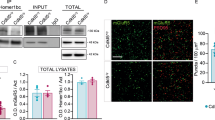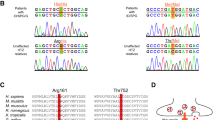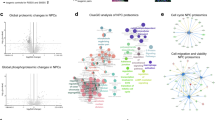Abstract
Rett syndrome is a monogenic disease due to de novo mutations in either MECP2 or CDKL5 genes. In spite of their involvement in the same disease, a functional interaction between the two genes has not been proven. MeCP2 is a transcriptional regulator; CDKL5 encodes for a kinase protein that might be involved in the regulation of gene expression. Therefore, we hypothesized that mutations affecting the two genes may lead to similar phenotypes by dysregulating the expression of common genes. To test this hypothesis we used induced pluripotent stem (iPS) cells derived from fibroblasts of one Rett patient with a MECP2 mutation (p.Arg306Cys) and two patients with mutations in CDKL5 (p.Gln347Ter and p.Thr288Ile). Expression profiling was performed in CDKL5-mutated cells and genes of interest were confirmed by real-time RT-PCR in both CDKL5- and MECP2-mutated cells. The only major change in gene expression common to MECP2- and CDKL5-mutated cells was for GRID1, encoding for glutamate D1 receptor (GluD1), a member of the δ-family of ionotropic glutamate receptors. GluD1 does not form AMPA or NMDA glutamate receptors. It acts like an adhesion molecule by linking the postsynaptic and presynaptic compartments, preferentially inducing the inhibitory presynaptic differentiation of cortical neurons. Our results demonstrate that GRID1 expression is downregulated in both MECP2- and CDKL5-mutated iPS cells and upregulated in neuronal precursors and mature neurons. These data provide novel insights into disease pathophysiology and identify possible new targets for therapeutic treatment of Rett syndrome.
Similar content being viewed by others
Log in or create a free account to read this content
Gain free access to this article, as well as selected content from this journal and more on nature.com
or
Accession codes
References
Rett A : Ueber ein eigenartiges hirnatrophisches Syndrom bei Hyperammonaemie im Kindesalter. Wien Med Wochenschrift 1966; 116: 723–726.
Chahrour M, Zoghbi HY : The story of Rett syndrome: from clinic to neurobiology. Neuron 2007; 56: 422–437.
Hagberg B, Aicardi J, Dias K, Ramos O : A progressive syndrome of autism, dementia, ataxia, and loss of purposeful hand use in girls: Rett’s syndrome: report of 35 cases. Ann Neurol 1983; 14: 471–479.
Williamson SL, Christodoulou J : Rett syndrome: new clinical and molecular insights. Eur J Hum Genet 2006; 14: 896–903.
Artuso R : Early-onset seizure variant of Rett syndrome: definition of the clinical diagnostic criteria. Brain Dev 2010; 32: 17–24.
Neul J, Kaufmann W, Glaze D et al: Rett syndrome: revised diagnostic criteria and nomenclature. Ann Neurol 2010; 68: 944–950.
Amir RE, Zoghbi HY : Rett syndrome: methyl-CpG-binding protein 2 mutations and phenotype-genotype correlations. Am J Med Genet 2000; 97: 147–152.
LaSalle JM, Goldstine J, Balmer D, Greco CM : Quantitative localization of heterogeneous methyl-CpG-binding protein 2 (MeCP2) expression phenotypes in normal and Rett syndrome brain by laser scanning cytometry. Hum Mol Genet 2001; 10: 1729–1740.
Shahbazian MD, Antalffy B, Armstrong DL, Zoghbi HY : Insight into Rett syndrome: MeCP2 levels display tissue- and cell-specific differences and correlate with neuronal maturation. Hum Mol Genet 2002; 11: 115–124.
Jordan C, Li HH, Kwan HC, Francke U : Cerebellar gene expression profiles of mouse models for Rett syndrome reveal novel MeCP2 targets. BMC Med Genet 2007; 8: 36.
Tudor M, Akbarian S, Chen RZ, Jaenisch R : Transcriptional profiling of a mouse model for Rett syndrome reveals subtle transcriptional changes in the brain. Proc Natl Acad Sci USA 2002; 99: 15536–15541.
Roux JC, Zala D, Panayotis N, Borges-Correia A, Saudou F, Villard L : Modification of Mecp2 dosage alters axonal transport through the Huntingtin/Hap1 pathway. Neurobiol Dis 2012; 45: 786–795.
Belichenko PV, Oldfors A, Hagberg B, Dahlstrom A : Rett syndrome: 3-D confocal microscopy of cortical pyramidal dendrites and afferents. Neuroreport 1994; 5: 1509–1513.
Colantuoni C, Jeon OH, Hyder K et al: Gene expression profiling in postmortem Rett Syndrome brain: differential gene expression and patient classification. Neurobiol Dis 2001; 8: 847–865.
Blue ME, Naidu S, Johnston MV : Altered development of glutamate and GABA receptors in the basal ganglia of girls with Rett syndrome. Exp Neurol 1999; 156: 345–352.
Johnston MV, Blue ME, Naidu S : Rett syndrome and neuronal development. J Child Neurol 2005; 20: 759–763.
Evans J, Archer H, Colley J et al: Early onset seizures and Rett-like features associated with mutations in CDKL5. Eur J Hum Genet 2005; 13: 1113–1120.
Scala E, Ariani F, Mari F et al: CDKL5/STK9 is mutated in Rett syndrome variant with infantile spasms. J Med Genet 2005; 42: 103–107.
Montini E, Andolfi G, Caruso A et al: Identification and characterization of a novel serine-threonine kinase gene from the Xp22 region. Genomics 1998; 51: 427–433.
Lin C, Franco B, Rosner MR : CDKL5/Stk9 kinase inactivation is associated with neuronal developmental disorders. Hum Mol Genet 2005; 14: 3775–3786.
Rusconi L, Salvatoni L, Giudici L et al: CDKL5 expression is modulated during neuronal development and its subcellular distribution is tightly regulated by the C-terminal tail. J Biol Chem 2008; 283: 30101–30111.
Rusconi L, Kilstrup-Nielsen C, Landsberger N : Extrasynaptic N-methyl-D-aspartate (NMDA) receptor stimulation induces cytoplasmic translocation of the CDKL5 kinase and its proteasomal degradation. J Biol Chem 2011; 286: 36550–36558.
Ricciardi S, Ungaro F, Hambrock M et al: CDKL5 ensures excitatory synapse stability by reinforcing NGL-1-PSD95 interaction in the postsynaptic compartment and is impaired in patient iPSC-derived neurons. Nat Cell Biol 2012; 14: 911–923.
Kameshita I, Sekiguchi M, Hamasaki D et al: Cyclin-dependent kinase-like 5 binds and phosphorylates DNA methyltransferase 1. Biochem Biophys Res Commun 2008; 377: 1162–1167.
Nectoux J, Fichou Y, Rosas-Vargas H et al: Cell cloning-based transcriptome analysis in Rett patients: relevance to the pathogenesis of Rett syndrome of new human MeCP2 target genes. J Cell Mol Med 2010; 14: 1962–1974.
Mari F, Azimonti S, Bertani I et al: CDKL5 belongs to the same molecular pathway of MeCP2 and it is responsible for the early-onset seizure variant of Rett syndrome. Hum Mol Genet 2005; 14: 1935–1946.
Bertani I, Rusconi L, Bolognese F et al: Functional consequences of mutations in CDKL5, an X-linked gene involved in infantile spasms and mental retardation. J Biol Chem 2006; 281: 32048–32056.
Carouge D, Host L, Aunis D, Zwiller J, Anglard P : CDKL5 is a brain MeCP2 target gene regulated by DNA methylation. Neurobiol Dis 2010; 38: 414–424.
Takahashi K, Tanabe K, Ohnuki M et al: Induction of pluripotent stem cells from adult human fibroblasts by defined factors. Cell 2007; 131: 861–872.
Lowry WE, Richter L : Signaling in adult stem cells. Front Biosci 2007; 12: 3911–3927.
Marchetto MC, Brennand KJ, Boyer LF, Gage FH : Induced pluripotent stem cells (iPSCs) and neurological disease modeling: progress and promises. Hum Mol Genet 2011; 20: R109–R115.
Urbach A, Bar-Nur O, Daley GQ, Benvenisty N : Differential modeling of fragile X syndrome by human embryonic stem cells and induced pluripotent stem cells. Cell Stem Cell 2010; 6: 407–411.
Chamberlain SJ, Chen PF, Ng KY et al: Induced pluripotent stem cell models of the genomic imprinting disorders Angelman and Prader-Willi syndromes. Proc Natl Acad Sci U S A 2010; 107: 17668–17673.
Marchetto MC, Carromeu C, Acab A et al: A model for neural development and treatment of Rett syndrome using human induced pluripotent stem cells. Cell 2010; 143: 527–539.
Cheung AY, Horvath LM, Grafodatskaya D et al: Isolation of MECP2-null Rett Syndrome patient hiPS cells and isogenic controls through X-chromosome inactivation. Hum Mol Genet 2011; 20: 2103–2115.
Ananiev G, Williams EC, Li H, Chang Q : Isogenic pairs of wild type and mutant induced pluripotent stem cell (iPSC) lines from Rett syndrome patients as in vitro disease model. PLoS One 2011; 6: e25255.
Amenduni M, De Filippis R, Cheung AY et al: iPS cells to model CDKL5-related disorders. Eur J Hum Genet 2011; 19: 1246–1255.
Hotta A, Cheung AY, Farra N et al: Isolation of human iPS cells using EOS lentiviral vectors to select for pluripotency. Nat Methods 2009; 6: 370–376.
Yuan SH, Martin J, Elia J et al: Cell-surface marker signatures for the isolation of neural stem cells, glia and neurons derived from human pluripotent stem cells. PLoS One 2011; 6: e17540.
Safieddine S, Wenthold RJ : The glutamate receptor subunit delta1 is highly expressed in hair cells of the auditory and vestibular systems. J Neurosci 1997; 17: 7523–7531.
Yasui DH, Peddada S, Bieda MC et al: Integrated epigenomic analyses of neuronal MeCP2 reveal a role for long-range interaction with active genes. Proc Natl Acad Sci USA 2007; 104: 19416–19421.
Pennartz S, Belvindrah R, Tomiuk S et al: Purification of neuronal precursors from the adult mouse brain: comprehensive gene expression analysis provides new insights into the control of cell migration, differentiation, and homeostasis. Mol Cell Neurosci 2004; 25: 692–706.
Chahrour M, Jung SY, Shaw C et al: MeCP2, a key contributor to neurological disease, activates and represses transcription. Science 2008; 320: 1224–1229.
Chen Q, Zhu YC, Yu J et al: CDKL5, a protein associated with Rett syndrome, regulates neuronal morphogenesis via Rac1 signaling. J Neurosci 2010; 30: 12777–12786.
Ricciardi S, Kilstrup-Nielsen C, Bienvenu T, Jacquette A, Landsberger N, Broccoli V : CDKL5 influences RNA splicing activity by its association to the nuclear speckle molecular machinery. Hum Mol Genet 2009; 18: 4590–4602.
Nectoux J, Fichou Y, Cagnard N et al: Cell cloning-based transcriptome analysis in cyclin-dependent kinase-like 5 mutation patients with severe epileptic encephalopathy. J Mol Med (Berl) 2011; 89: 193–202.
Traynor J, Agarwal P, Lazzeroni L, Francke U : Gene expression patterns vary in clonal cell cultures from Rett syndrome females with eight different MECP2 mutations. BMC Med Genet 2002; 3: 12.
Yamazaki M, Araki K, Shibata A, Mishina M : Molecular cloning of a cDNA encoding a novel member of the mouse glutamate receptor channel family. Biochem Biophys Res Commun 1992; 183: 886–892.
Lomeli H, Sprengel R, Laurie DJ et al: The rat delta-1 and delta-2 subunits extend the excitatory amino acid receptor family. FEBS Lett 1993; 315: 318–322.
Mayat E, Petralia RS, Wang YX, Wenthold RJ : Immunoprecipitation, immunoblotting, and immunocytochemistry studies suggest that glutamate receptor delta subunits form novel postsynaptic receptor complexes. J Neurosci 1995; 15: 2533–2546.
Yasumura M, Yoshida T, Lee SJ, Uemura T, Joo JY, Mishina M : Glutamate receptor delta1 induces preferentially inhibitory presynaptic differentiation of cortical neurons by interacting with neurexins through cerebellin precursor protein subtypes. J Neurochem 2012; 121: 705–716.
Kuroyanagi T, Yokoyama M, Hirano T : Postsynaptic glutamate receptor delta family contributes to presynaptic terminal differentiation and establishment of synaptic transmission. Proc Natl Acad Sci USA 2009; 106: 4912–4916.
Ryu K, Yokoyama M, Yamashita M, Hirano T : Induction of excitatory and inhibitory presynaptic differentiation by GluD1. Biochem Biophys Res Commun 2012; 417: 157–161.
Belichenko PV, Wright EE, Belichenko NP et al: Widespread changes in dendritic and axonal morphology in Mecp2-mutant mouse models of Rett syndrome: evidence for disruption of neuronal networks. J Comp Neurol 2009; 514: 240–258.
Chapleau CA, Calfa GD, Lane MC et al: Dendritic spine pathologies in hippocampal pyramidal neurons from Rett syndrome brain and after expression of Rett-associated MECP2 mutations. Neurobiol Dis 2009; 35: 219–233.
Chao HT, Zoghbi HY, Rosenmund C : MeCP2 controls excitatory synaptic strength by regulating glutamatergic synapse number. Neuron 2007; 56: 58–65.
Gatto CL, Broadie K : Genetic controls balancing excitatory and inhibitory synaptogenesis in neurodevelopmental disorder models. Front Synaptic Neurosci 2010; 2: 4.
Dani VS, Chang Q, Maffei A, Turrigiano GG, Jaenisch R, Nelson SB : Reduced cortical activity due to a shift in the balance between excitation and inhibition in a mouse model of Rett syndrome. Proc Natl Acad Sci USA 2005; 102: 12560–12565.
Medrihan L, Tantalaki E, Aramuni G et al: Early defects of GABAergic synapses in the brain stem of a MeCP2 mouse model of Rett syndrome. J Neurophysiol 2008; 99: 112–121.
Zhang ZW, Zak JD, Liu H : MeCP2 is required for normal development of GABAergic circuits in the thalamus. J Neurophysiol 2010; 103: 2470–2481.
Nguyen L, Rigo JM, Rocher V et al: Neurotransmitters as early signals for central nervous system development. Cell Tissue Res 2001; 305: 187–202.
Manent JB, Represa A : Neurotransmitters and brain maturation: early paracrine actions of GABA and glutamate modulate neuronal migration. Neuroscientist 2007; 13: 268–279.
Aronica E, Crino PB : Inflammation in epilepsy: clinical observations. Epilepsia 2011; 52 (Suppl 3): 26–32.
Zweier C, de Jong EK, Zweier M et al: CNTNAP2 and NRXN1 are mutated in autosomal-recessive Pitt-Hopkins-like mental retardation and determine the level of a common synaptic protein in Drosophila. Am J Hum Genet 2009; 85: 655–666.
Marangi G, Ricciardi S, Orteschi D et al: Proposal of a clinical score for the molecular test for Pitt-Hopkins syndrome. Am J Med Genet A 2012; 158A: 1604–1611.
Grillo E, Lo Rizzo C, Bianciardi L et al: Revealing the complexity of a monogenic disease: Rett syndrome exome sequencing. PLoS One 2013; 8: e56599.
Fallin MD, Lasseter VK, Avramopoulos D et al: Bipolar I disorder and schizophrenia: a 440-single-nucleotide polymorphism screen of 64 candidate genes among Ashkenazi Jewish case-parent trios. Am J Hum Genet 2005; 77: 918–936.
Glessner JT, Hakonarson H : Common variants in polygenic schizophrenia. Genome Biol 2009; 10: 236.
Guo SZ, Huang K, Shi YY et al: A case-control association study between the GRID1 gene and schizophrenia in the Chinese Northern Han population. Schizophr Res 2007; 93: 385–390.
Treutlein J, Muhleisen TW, Frank J et al: Dissection of phenotype reveals possible association between schizophrenia and Glutamate Receptor Delta 1 (GRID1) gene promoter. Schizophr Res 2009; 111: 123–130.
Yadav R, Gupta SC, Hillman BG, Bhatt JM, Stairs DJ, Dravid SM : Deletion of glutamate delta-1 receptor in mouse leads to aberrant emotional and social behaviors. PLoS One 2012; 7: e32969.
Acknowledgements
We are grateful to A Bartolini for help with culture maintenance and differentiation. The work was partially funded by Telethon grant (GGP11110A), by Italian Health Ministry ‘Ricerca finalizzata 2008’ (RF-TOS-2008_1225570) and ‘Ricerca finalizzata 2010’ (RF-2010-2317597) grants, and by AIRETT (Associazione Italiana Rett) 2011 grant to AR. The ‘Cell lines and DNA bank of Rett Syndrome, X-linked mental retardation and other genetic diseases’, member of the Telethon Network of Genetic Biobanks (project no. GTB12001), funded by Telethon Italy, and of the EuroBioBank network, provided us with specimens.
Author information
Authors and Affiliations
Corresponding author
Ethics declarations
Competing interests
The authors declare no conflict of interest.
Additional information
Supplementary Information accompanies this paper on European Journal of Human Genetics website
Rights and permissions
About this article
Cite this article
Livide, G., Patriarchi, T., Amenduni, M. et al. GluD1 is a common altered player in neuronal differentiation from both MECP2-mutated and CDKL5-mutated iPS cells. Eur J Hum Genet 23, 195–201 (2015). https://doi.org/10.1038/ejhg.2014.81
Received:
Revised:
Accepted:
Published:
Issue date:
DOI: https://doi.org/10.1038/ejhg.2014.81
This article is cited by
-
JNK signaling provides a novel therapeutic target for Rett syndrome
BMC Biology (2021)
-
A familiar study on self-limited childhood epilepsy patients using hIPSC-derived neurons shows a bias towards immaturity at the morphological, electrophysiological and gene expression levels
Stem Cell Research & Therapy (2021)
-
High rate of HDR in gene editing of p.(Thr158Met) MECP2 mutational hotspot
European Journal of Human Genetics (2020)
-
Motifome comparison between modern human, Neanderthal and Denisovan
BMC Genomics (2018)
-
From molecules to medicines: the dawn of targeted therapies for genetic epilepsies
Nature Reviews Neurology (2018)



